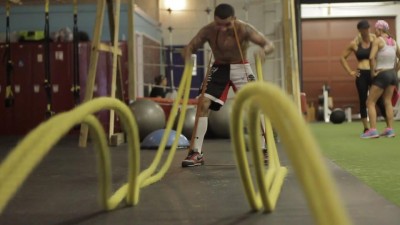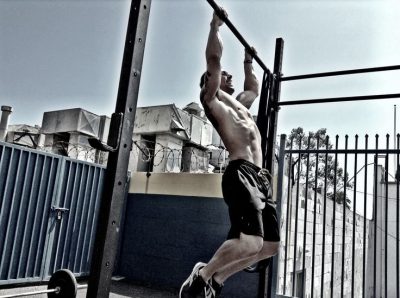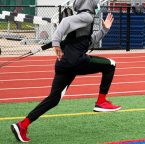Battle ropes may look really cool and provide good pictures for social media, but they are also a really good training tool for athletes.
Athletes are constantly searching for innovative and effective ways to take their physical abilities to the next level, and battle rope training represents a dynamic and challenging means of doing just that. With its unique combination of explosive movements, resistance training, and cardiovascular conditioning, battle rope training has rapidly emerged as a go-to training tool for athletes looking to push their bodies to the limit.
However, with so many different exercises and techniques available, incorporating battle rope training into an athlete’s workout routine can be a perplexing task. The sheer intensity and diversity of movements inherent in battle rope training require a high degree of concentration, focus, and muscular engagement, leading to a burst of energy and intensity that is unparalleled by other training modalities.
In this article, we’ll give you everything you need to know about battle rope training for athletes.
Let’s get this party started.
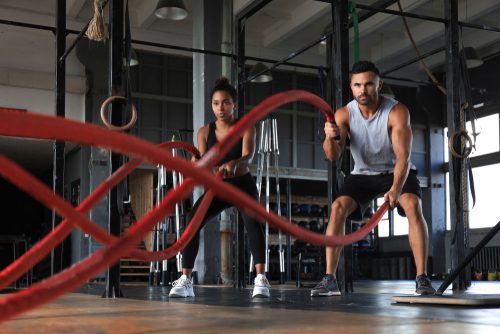
What is Battle Rope Training?
For those of you that have been living under a rock and don’t know what battle rope training is.
Battle rope training is a form of high-intensity interval training (HIIT) that uses thick rope strands to create resistance. The ropes are usually anchored to a post or wall and then used for exercises such as alternating waves, slams and biceps curls.
It is believed that battle rope training was first developed by Navy Seals in the 1980s as part of their strength and conditioning program but has since grown in popularity due to its effective results and relatively minimal equipment requirements. While they p a great workout, battle ropes can help improve coordination, endurance, speed and agility while developing muscle tone all over the body.
How Battle Rope Training Works
Looking for a full-body workout that will push you to the limits and take your athletic performance to new heights? Battle rope training might just be the answer you’ve been looking for. Using thick, heavy ropes anchored to a stable surface, this high-intensity workout requires dynamic, multi-joint movements that engage multiple muscle groups at once.
But battle rope training isn’t just about mindlessly swinging ropes around. There are a variety of movements and exercises involved that can challenge your coordination, balance, and endurance while building strength and power in your upper body and core. From creating waves and slamming the ropes down onto the ground to moving them in circles or performing jumping jacks, there’s a lot of room for creativity and variety in your battle rope workouts.
And the benefits don’t stop there. By engaging both upper and lower body muscles in these exercises, you’ll improve your overall functional fitness and athletic performance. The primary muscles worked during battle rope training are the shoulders, arms, and core, but your glutes, quads, and calves will also get in on the action.
So if you’re ready to take on a challenging, full-body workout that will leave you feeling stronger and more powerful than ever before, grab some ropes and give battle rope training a try. Your body (and your fitness goals) will thank you.
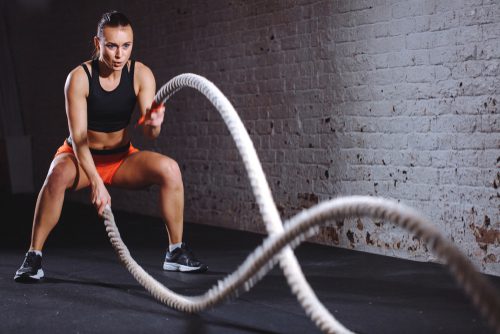
Benefits of Battle Rope Training for Athletes
There are some clear benefits to training with battle ropes. These include
Low Impact – Battle rope training is a low-impact form of exercise, making it ideal for athletes looking to reduce the impact on their joints.
Improved Cardiovascular Endurance – Due to the consistent and dynamic movement required in battle rope exercises, this form of training is great for improving cardiovascular endurance.
Improved Strength – Battle ropes provide a huge amount of resistance, particularly with longer and heavier ropes. This makes them an excellent tool for building strength in the arms, shoulders, and core.
Enhanced Athletic Performance – Because battle ropes require fast-paced movements that engage multiple muscles at once, this form of training can help improve speed, agility and coordination.
Increased grip strength – Battle rope training is a great way to develop grip strength, which can be beneficial for athletes in any sport.
Best Battle Rope Movements for Athletes
While there are a lot of battle rope movements, the basics are all you really need if you do them correctly and at high intensity.
Some of the basics include:
Two-Handed Slams
Stand with your feet shoulder-width apart and hold the rope in both hands. You will want to keep the ropes just inside shoulder width then raise them above eye level and “slam” them down with both hands while squatting down slightly and hinging at the waist as the ropes hit the ground and repeat.
Alternating Waves
Stand with your feet shoulder-width apart and hold the rope in both hands. Create alternating waves by quickly moving your arms up and down in opposite directions.
Lateral Waves
You may have noticed that you can pretty much figure out how to do these just by the name of the exercises. For lateral waves, stand with your feet shoulder-width apart and hold the rope in both hands. Create lateral waves by quickly moving your arms side to side in a wave motion, while keeping them extended at chest level.
Alternating Waves aka Machine Gun Kelley’s
For this exercise, you make waves with the ropes in an alternating fashion as the name implies.
These are all about speed hence the nickname’ Machine Guns” the goal is to create as many waves as you can in the time you’re doing a set. These are great if you want to blast your arms and delts and have them feeling like jelly.
Double Dutch
This battle rope exercise has you swinging the rope in large circular waves like you are doing double dutch with a jump rope. Your right arm will move clockwise and your left arm will move counterclockwise. Two things will begin to happen the rope will show ‘spirals ‘or ‘loops’ moving toward the point which is normal. I like this movement because of the added ancillary work for the smaller external rotators.
Tabata Training with Battle Ropes
Want a battle ropes workout that will blast the fat off and won’t take long? Try a battle ropes workout with Tabata training.
For this type of workout, you perform exercises like waves, slams, and curls for 20 seconds at high intensity, with 10-second rest periods in between. The goal is to work as hard as possible during the exercises for maximum benefit.
Tabata battle rope training offers an intense full-body workout in a relatively short amount of time, helping users burn calories, improve coordination and agility, develop muscle tone, and increase endurance.
You should know that Tabata workouts are so hard that most people can’t even finish them. At least not making the 100% effort they are supposed to give during the high-intensity phase.
Related: Battle Ropes for Beginners
Related: Jumping Rope for Athletes
Related: The 10 Commandments of Athletic Muscle
Final Word
Battle rope training is an incredibly effective and efficient way to improve strength, athletic performance, grip strength and cardiovascular endurance. With the right movements performed at high intensity, athletes can get a powerful full-body workout in a relatively short amount of time.
And by utilizing Tabata training principles, they can maximize their results even further. So if you want to take your workouts and performance to the next level, give battle ropes a try! They just might be the perfect addition to your routine.

Ryan is a former college wrestler and lifelong fitness fanatic. He has run half marathons, done mud runs, placed in body transformation contests, coached wrestling, and now coaches girls’ soccer. Not to mention he has also tried literally hundreds of supplements over the years and has a vast and thorough supplement knowledge. He has written for Muscle & Strength, Testosterone Junkie, The Sport Review and other publications. He is also the editor-in-chief of this website and has over 25 years of experience in the fitness industry. Feel free to connect with him on his LinkedIn page below.

